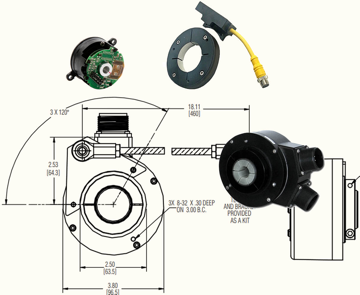Optical encoders use a glass disk with a pattern of lines deposited on it, a metal or plastic disk with slots (in a rotary encoder), or a glass or metal strip (in a linear encoder). Light from an LED shines through the disk or strip onto one or more photodetectors, which produce the encoder’s output. An incremental encoder has one or more of these tracks, while an absolute encoder has as many tracks as it has output bits.
London Rhodes
Recent Posts
How Does an Optical Encoder Produce a Signal?
Posted by London Rhodes on Sep 29, 2021 1:52:06 PM
Topics: How to Choose An Encoder, Encoder Signals Output, Optical Encoders
What Are Indications of Good Encoder Output?
Posted by London Rhodes on Sep 29, 2021 1:41:32 PM
Topics: Installation, Encoder Signals Output, Troubleshooting
Where do I Connect The Oscilloscope Leads?
Posted by London Rhodes on Sep 29, 2021 8:58:07 AM
The ground leads of the oscilloscope should be connected to the common on the encoder. The probe clips should be connected to the channel you are measuring. The encoder should be powered and rotating for the oscilloscope to get a proper reading.
How Do I Use an Encoder and Measuring Wheel on a Conveyor System?
Posted by London Rhodes on Sep 29, 2021 8:53:21 AM
Dynapar offers a three piece solution for conveyor systems including an encoder, measuring wheel and bracket. A few brackets are specifically designed for use on a conveyor.
Topics: How to Choose An Encoder, Installation, Absolute Encoders
What Should I Consider When Installing an Encoder Tether?
Posted by London Rhodes on Aug 27, 2021 2:10:16 PM
Encoder tethers are designed and engineered to allow the encoder to float with the run-out of the motor shaft. If the tether is bolted too rigidly to the motor, then run-out from the motor can damage the encoder bearings. It is critical to use the parts provided with the encoder during installation to ensure the tether is properly placed. Avoid bending the tether from the position in which it is provided from the factory.
Topics: Installation, Troubleshooting
Why are Tethers Important for Encoders?
Posted by London Rhodes on Aug 27, 2021 2:01:41 PM
Without a functional tether, the wobble from the motor shaft will create additional wear on encoder bearings causing them to fail. Friction from bearing failure will cause encoder electronics to overheat.
Topics: Installation, Troubleshooting
What is an Encoder Tether?
Posted by London Rhodes on Aug 27, 2021 1:59:00 PM
A tether is an anti rotation device mounted between motor and encoder to ensure the encoder remains stationary while the motor is running.
Topics: Installation, Absolute Encoders, Troubleshooting
What Are Dynapar Phenolic Measuring Wheels Made Of?
Posted by London Rhodes on Aug 27, 2021 1:51:23 PM
In order to provide manufacturing flexibility, the 16002070177 Measuring Wheels can be made from Garolite G10, CE, LE or XX. Depending on the grade the color could be green, brown or black. We also offer rubber measuring wheels.
Topics: Measuring Wheels
How Many Shaft Positions Exist on Absolute Encoders?
Posted by London Rhodes on Jul 29, 2021 10:33:47 AM
You can calculate the number of shaft positions on your encoder with the following equation: 2x where X = the resolution of your absolute encoder in bits.
Topics: Installation, Absolute Encoders, Encoder Signals Output, Troubleshooting
How to Calculate Frequency Response?
Posted by London Rhodes on Jul 29, 2021 10:30:48 AM
RPM x PPR / 60 = Frequency Response in Hertz
Topics: Troubleshooting

